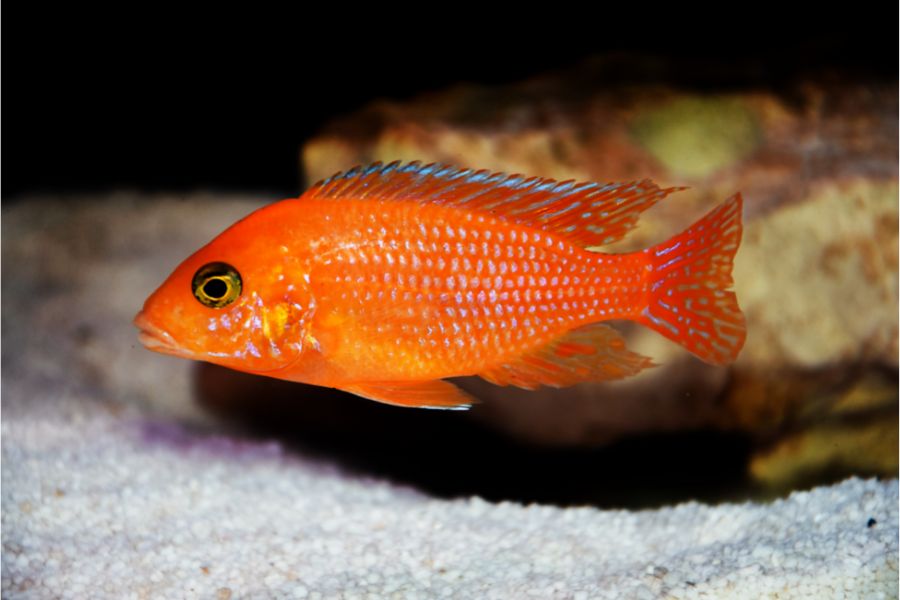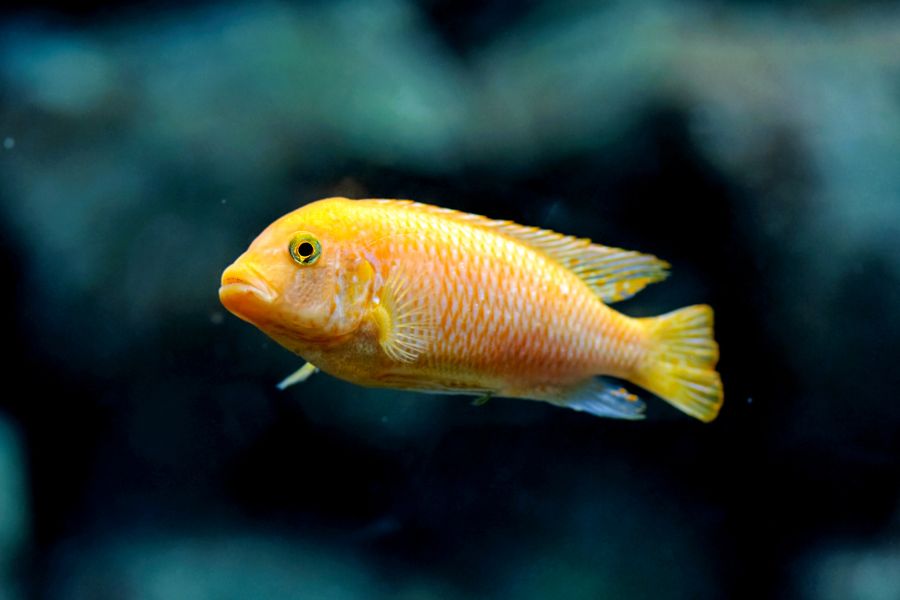The red zebra cichlid (Maylandia estherae) is a territorial fish that can bully less aggressive tank mates to death (in extreme cases).
When caring for such a species, the biggest care guide step is to ensure you have compatible tank mates and a large tank with enough space for the red zebras to call their own.
Apart from that, the red zebra cichlids are pretty easy to care for. They are hardy fish with a wide range of food sources that make them a great species to keep for more than five years. Also, they come with beautifully colored bodies that will make your tank pop.
Read on to learn all the important facts about red zebra cichlids. Get to know their origin and physical characteristics.
All you need to know to carefully and successfully care for the gorgeous species is outlined in detail below.
Red Zebra Cichlids Overview
Short Summary of Red Zebra Cichlids and their habitats:
| Names | Red Zebra Cichlids (Maylandia estherae)
Also known as the African cichlid, red zebra mbuna, Assorted African cichlid, or the Esther Grant’s Zebra |
| Origins and Reginal Distribution | Originated from Lake Malawi |
| Tank Size | 55 gallons Minimum for a community
75 gallons minimum for adults and breeding purposes |
| Water Hardness Conditions | 18 – 20 DH |
| Ideal Tank Mates | Less aggressive, equal sized fish. Thrives with other cichlids like Jewel cichlids, the Kribensis cichlid, yellow lab cichlids, and strawberry peacock cichlids. |
| Average Size | 4– 5 inches, more than 5 inches in the ideal environment |
| Colors | Red, but are polymorphic with other colors including orange, blue, brown, and beige. |
| Lifespan | Typically, 5 years, but can live up to 10 years in the ideal environment |
| Diet | Omnivorous diet – vegetables are preferred |
| Optimal pH levels | 7.5 – 8.4 |
| Optimal Temperature | 75 – 80 degrees Fahrenheit |
Red zebra cichlids belong to the African cichlid category. A lot of people ask if a red zebra is a Mbuna. And, yes, the red zebra does belong to the mbuna family of African cichlids.
In fact, it is popularly called the red zebra mbuna in many pet stores you might visit to purchase them.
The Red zebra cichlids are rock-dwellers, and this affects what type of tank you put them in. Rocks, caves, and hiding spots go a long way toward simulating their natural habitat on the coasts of Lake Malawi.
Lifespan
The lifespan of the red zebra mbuna is about 5 to 10 years in an ideal environment.
This is the same lifespan as other African cichlid species like the yellow labs and the severum cichlids.
Appearance: Colors & Size
So, how big do red zebra cichlids get? The average size is between 4 inches and 5 inches. Females are generally smaller than males, but this won’t be helpful in differentiating their sexes; more on that later.
It is rare for you to find adult zebras that span wider than 5 inches. If you do, then you should definitely buy it because it is from a hardier stock and will give you better value for your money.
But also keep in mind longer fish are older and more likely to die faster than younger fish.
Red is their naturally distinct color, but you will find them in huge varieties, from red zebras without stripes to striped ones that look a bit orange. Other colors include yellow, pink, brown, and beige.
Behaviors
They can get a bit aggressive, but they are more territorial than they are aggressive. Regardless, it is advisable to always keep them in a tank filled with other mbuna fish.
In their pursuit for territory, the red zebras will often destroy some of your live plants that do not have strong roots. It is a good practice to keep the tank with hardy plants with tougher roots or fill the aquarium with more rocks and artificial plants.
How Do You Take Care of A Red Zebra Cichlid?
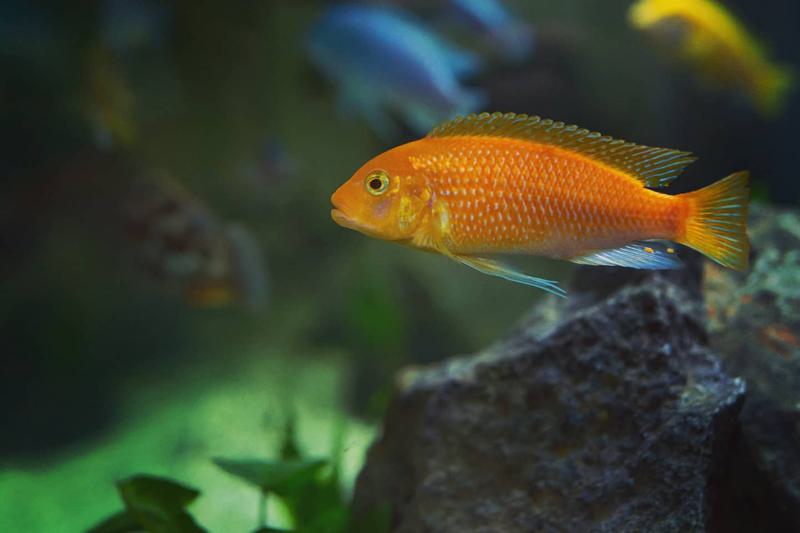
You won’t need much to create a thriving environment for zebra mbuna cichlids. Most of what you will have to do to ensure their success is to keep the right tank mates, give them enough space, and avoid overfeeding.
Tank Size & Environment
It is best if you do not place the African cichlids in a tank of less than 55 gallons.
One male red zebra can thrive with three to four females if they are placed in a 30-gallon tank, but this will get small very quickly when they start to breed.
A bigger tank is always needed; anything above 75 to 100 gallons is ideal.
Also, the red zebra cichlid’s aggression is lesser than its territorial behavior. You will notice this more often when they start to breed. The male will carve out its own space and get more aggressive around its tank mates.
Tank Mates
If you choose to put them next to less aggressive fish like the catfish and the plecos, then it would be best to include lots of hiding spots.
Put the red zebras next to similarly tempered cichlids to limit their aggression. Many cichlids can go with the red zebra cichlid. This ranges from the popular rainbow cichlids to the yellow lab cichlids.
The best red zebra cichlid tank mates include:
- Yellow lab cichlids
- Yellow tail acei cichlids
- Blue dolphin cichlids
- Jewel cichlids
- Kribensis cichlid
- Neon Blue Acera cichlid
- Rusty cichlids
- Zebra cichlids
- Strawberry peacock cichlids
- Rainbow sharks
Please do not forget about simulating the red zebra’s natural habitat, which includes putting rocks and rock-dwelling fish décor in the tank.
The ‘natural’ surrounding will ensure that the fish is kept in a less stressful environment, and this will increase the lifespan and general health of your community. Also, a natural rock-dwelling place will give the fish enough spots to call their territory.
Like other African cichlids, the red zebras are notoriously active eaters, which translates to a higher biowaste.
The species is messier than your average tank fish, and investing in a good filtration system plus a test kit will go a long way to keeping your tank clean.
Recommended cleaning involves weekly testing as well as a weekly 25% water change to offset the high feeding rate.
Water Quality & Water Parameters
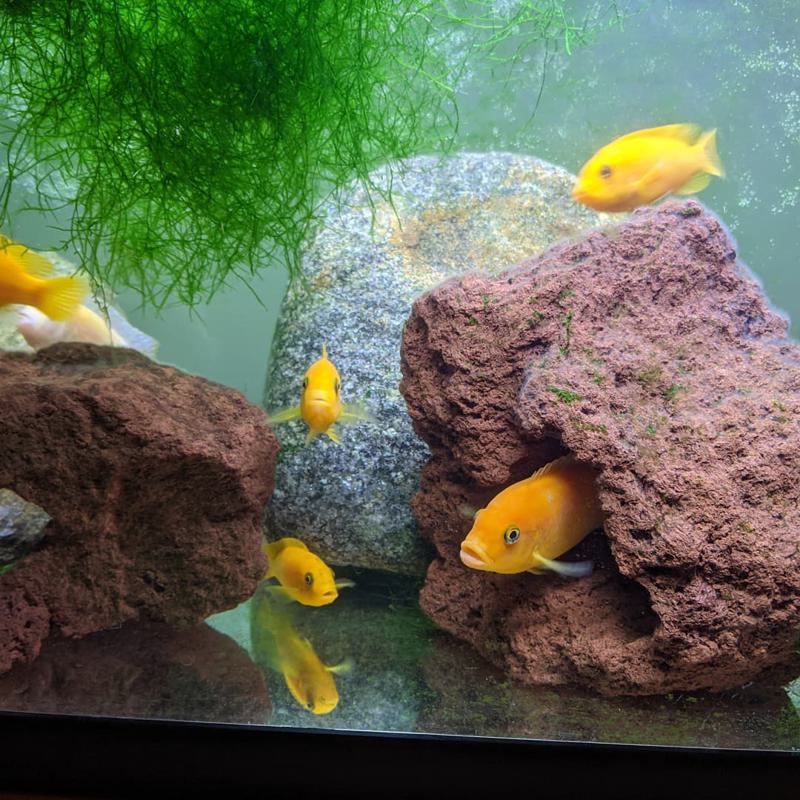
Standard water quality basics will ensure you have a thriving community of red zebras. They are hardy, and you won’t lose them if the water parameters drop from time to time. However, it is always best to keep the ideal parameters stable.
A common issue that affects the red zebra is bad pH levels. For the African cichlids, anything below 7.4 is dangerous. It is best to keep the levels above 7.4, but you can have more wiggle room till about 8.8. Other important parameters:
- Water Temperature: 75 – 80 degrees Fahrenheit
- pH level: 5 – 8.4
- Water hardness: semi-hard between 18 – 20 DH
- Ammonia, nitrite levels: 0 PPM
Red Zebra Cichlid Diet
Please ensure that high-protein foods are not their main diet. The red zebras are omnivores, but they prefer an herbivorous diet in an aquarium/tank environment.
Some of their best treats include veggie flakes and cichlid flakes. You can also include pieces of spinach, peas, and zucchini.
Keep the diet light and tiny by feeding them smaller portions throughout the day. A large meal once or twice a day will make them produce more waste, and you will find most of it is left floating in the water.
Feed the red zebra cichlids tiny pieces of the veggies and ensure they are able to eat all of it in under ten minutes. This helps regulate their intake to prevent diseases like the Malawi bloat and also ensures you have fewer leftovers to deal with.
As active eaters, the reed zebras also prefer a few bites of algae, and they will feed on smaller creatures like insects and small invertebrates, from zooplankton to snails, nymphs, and crustaceans.
Monitor what the fish eat inside the tank to further ensure they are not overfed. If you have enough natural food in the tank, then you can further limit how much outside food you add into the tank for them.
Breeding
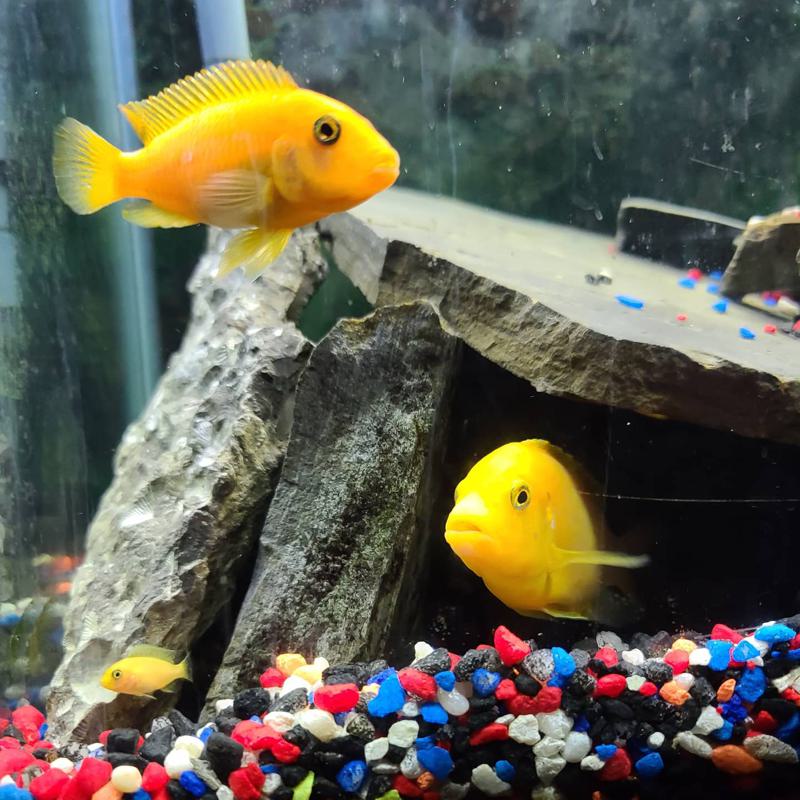
The red zebra cichlids are maternal mouthbrooders. This means that the eggs get carried into the fish’s mouth, where they are fertilized and then hatch to bring forth the offspring.
The process starts when the male cichlid curves its territory in the rocks and shows off its beautiful darker colors to entice the female.
If the female is attracted (competition is key), then she will proceed to go lay eggs in the rocky caves, after which she will immediately place them in her mouth (buccal cavity).
Knowing if the fish is a red zebra cichlid male or female is important for the next phase. Please keep in mind that it is harder to differentiate between the males and the females in this species.
Other cichlids tend to differentiate themselves by the males being larger, which is not always the case for the red zebra cichlids. Also, since red zebras are polymorphic, the males and females both come in a variety of colors that can mix and match between the sexes.
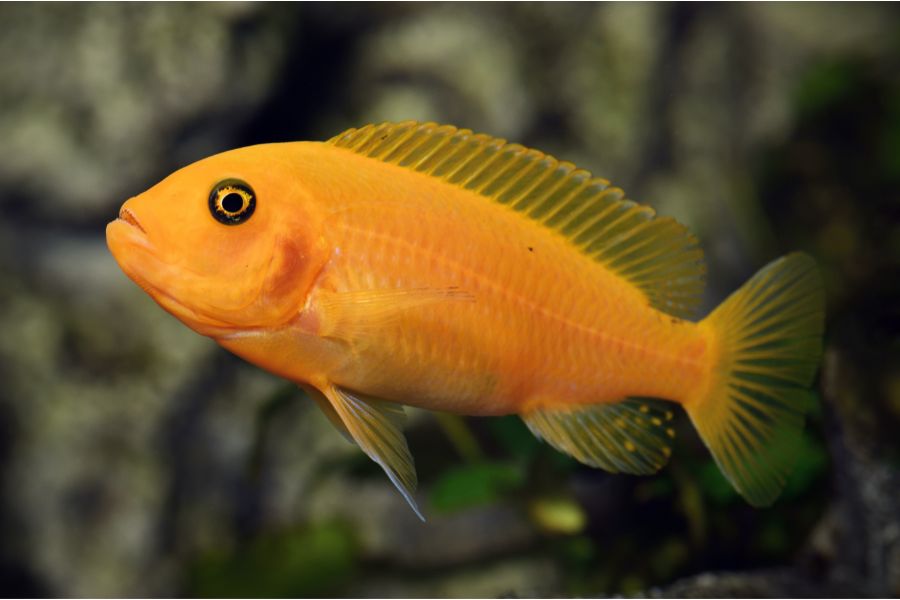
The main distinction that you can easily find is that females are darker in color while males are lighter. If the fishes are red, the females will have a stronger red color than the male red zebras.
This applies across all color variants, from orange to blue to brown to beige. Please remember that this does not apply to all African cichlid species since others, like the yellow lab cichlids, have males that have more intense coloration than females.
It is also easier to differentiate between the two sexes once they get much older (breeding age).
Male red zebras will have more egg spots on the anal fins than their female counterparts; sometimes, the females have zero. Adult red zebras develop these egg spots on their anal fins, which are vital for their breeding process.
Back to the female putting the laid eggs in her mouth. Once this is done, the egg-like spots on the male will attract the female, who will attempt to put them in her mouth because of how similar the egg spots are to the female eggs.
Once the female gets closer to the spots, the male proceeds to ejaculate into the female’s mouth, and that is how the eggs get fertilized.
The mother will then hold the eggs (typically, more than 30 eggs are laid at once) in her mouth for about two to three weeks. The eggs will then hatch, and the fry will take about two more weeks to absorb the egg sac because of the sac’s huge size.
The mother maternally takes care of their young ones during this period, and the process takes about four weeks before the fry are able to swim freely on their own.
TIP: Use a spare tank to put the female from the fries because the females have a bad habit of eating the fries. It is also a good practice to separate the breeding pairs into different tanks (one male and three females). This limits aggression and ensures a smooth breeding season.
Best parameters for red zebra cichlids to breed:
- Temperature: 75 – 80 degrees Fahrenheit
- Diet: High Vegetable Diet, fewer proteins/meats diet (good foods include fry fish and fry groundfish flakes)
- Water pH levels: Above 7.8, the ideal is between 8.0 – 8.4
- Water Hardness: semi-hard between 18 – 20 DH
Also Read:
Summing Up
Illnesses are the main headache when it comes to keeping fish. Look out for common red zebra cichlid illnesses like swim bladder disease, Ich, and Malawi bloat.
You will avoid losing your precious pets to these diseases if you prioritize good pH levels, avoid overfeeding, have the right tank mates, and put them in a bigger tank.
